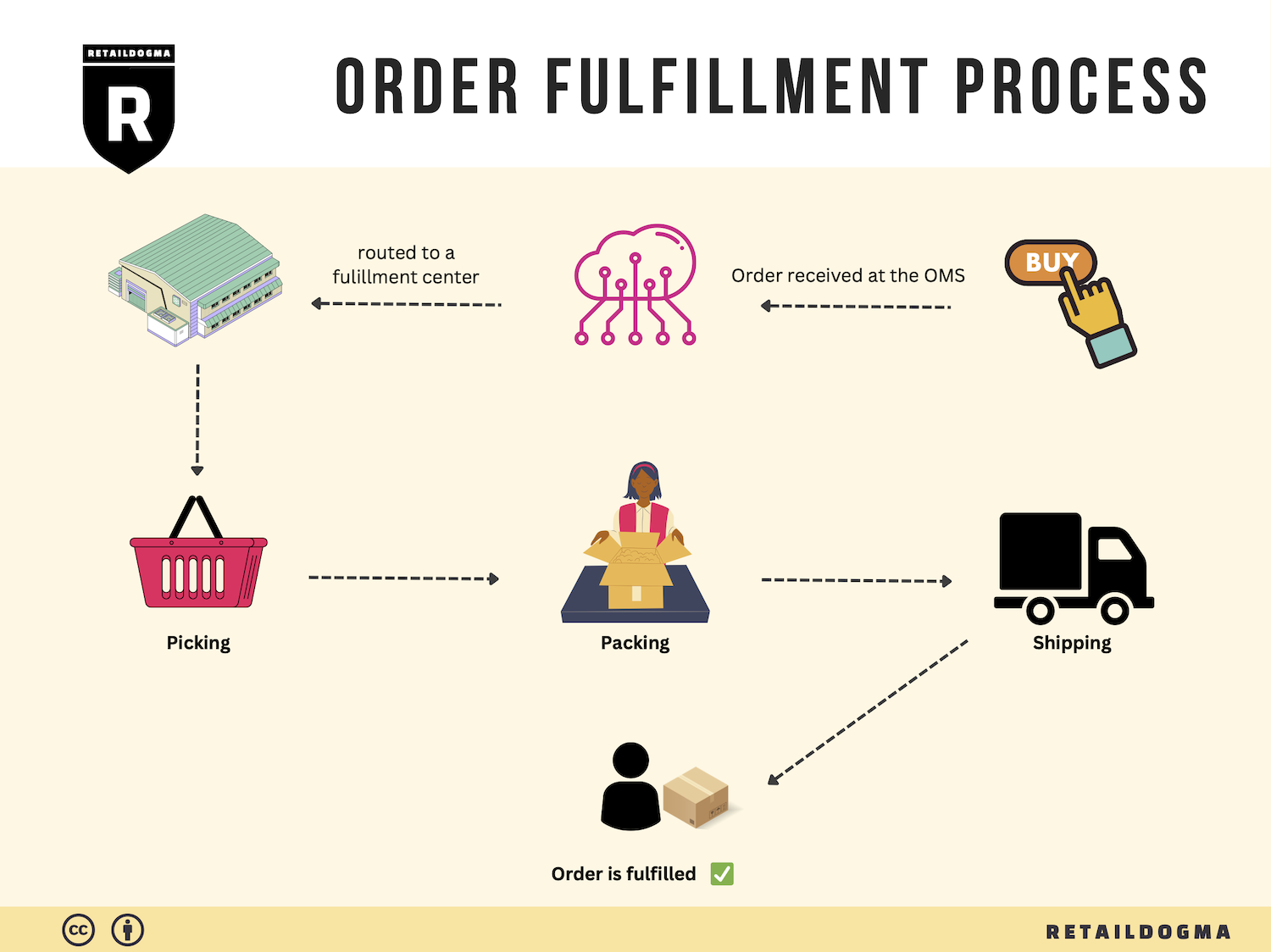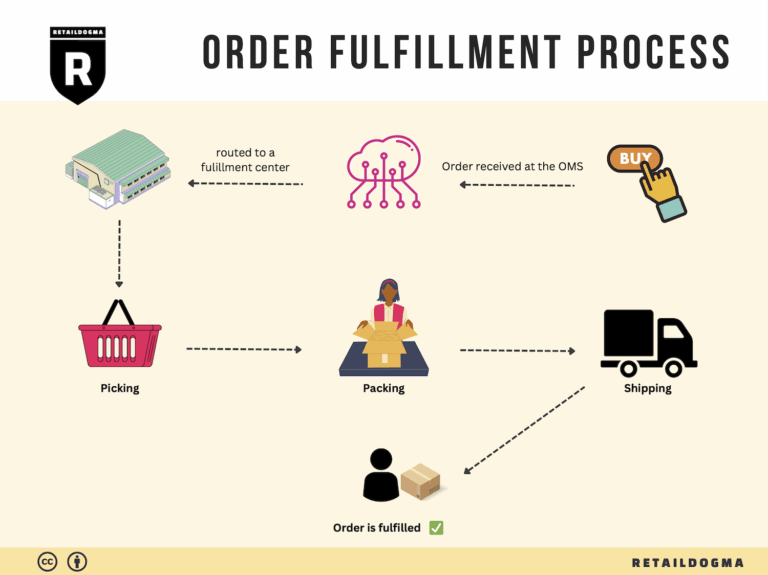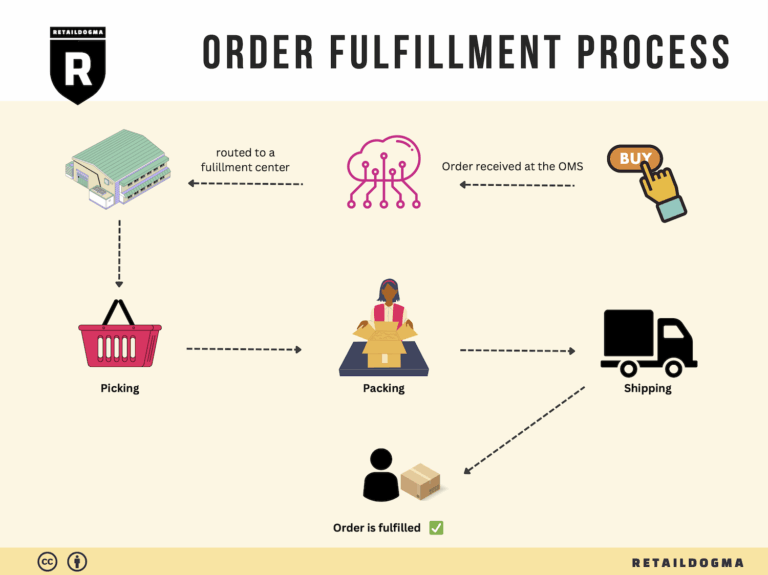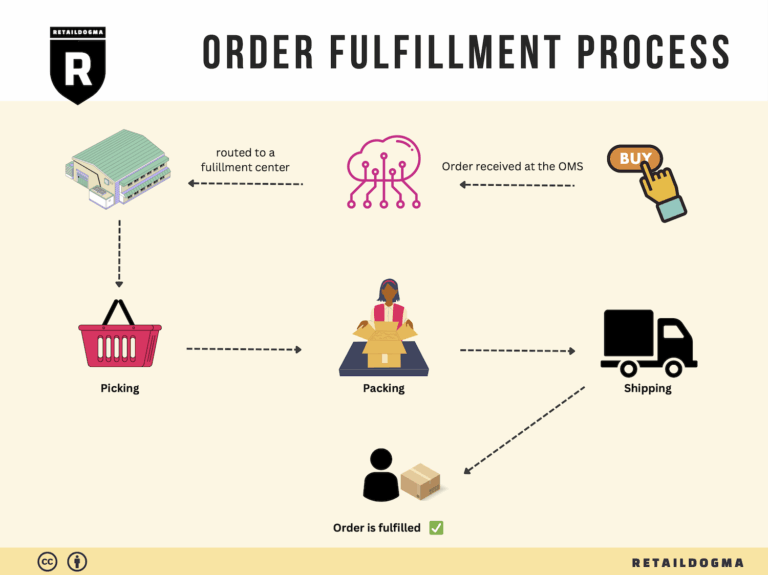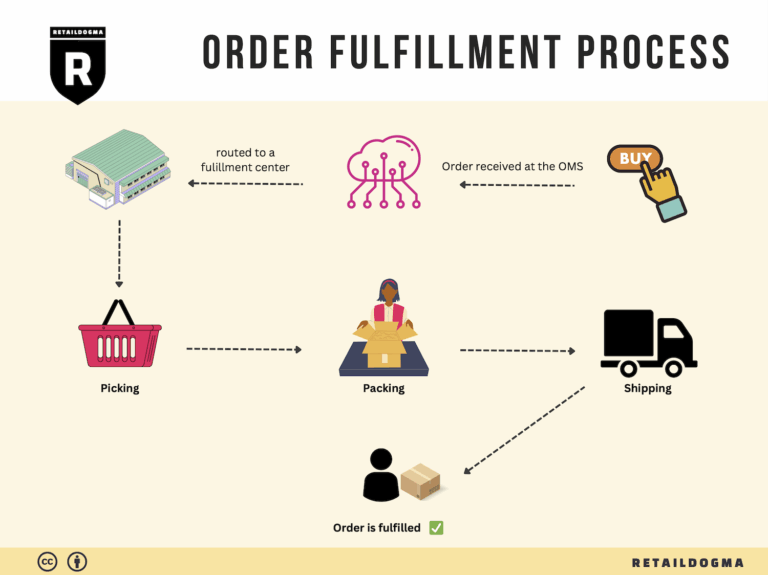What Is A Fulfillment Center? A Complete Guide (2025)
What is E-commerce Fulfillment? An Introduction for Growing Businesses
Understanding the Challenges of Order Management
As an e-commerce business owner, you may have experienced the frustration of managing packing and shipping logistics. The excitement of making sales can quickly turn into overwhelm when orders start pouring in. The reality of picking, packing, and shipping products can consume valuable time and resources, diverting your attention from scaling your business. This is where understanding e-commerce fulfillment becomes crucial.
Defining E-commerce Fulfillment
At its core, fulfillment refers to the process of getting a product from your warehouse or fulfillment center to your customer’s doorstep. This process encompasses various stages, including inventory management, order processing, packing, shipping, and delivery. As your business grows, mastering these stages becomes essential to maintaining customer satisfaction and optimizing your operations.
What This Guide Covers
In this guide, we will explore different fulfillment models that can help you manage your logistics more efficiently. You’ll learn about:
- Third-Party Logistics (3PL): Partnering with external providers to handle warehousing, inventory, and shipping on your behalf.
- Fulfillment by Amazon (FBA): Leveraging Amazon’s vast network of fulfillment centers, including the PHX6 location in Phoenix, to streamline your shipping process.
We will also delve into the core services that fulfillment partners typically offer, such as order processing, returns management, and real-time tracking. Understanding these services will help you identify what you need from a fulfillment partner.
Choosing the Right Partner
Selecting the right fulfillment partner is a critical decision for your growing business. We’ll provide practical tips on how to evaluate potential partners, including factors like location, technology integration, scalability, and customer service.
Pricing Insights
Understanding the cost structure of fulfillment services is essential for budgeting and financial planning. We will break down common pricing models, helping you to anticipate expenses and evaluate the return on investment for various fulfillment options.

Empowering Smart Decisions
The ultimate goal of this guide is to empower you to make informed decisions about your logistics strategy. By understanding the complexities of e-commerce fulfillment and the options available, you can choose the best path for your business. Whether you’re looking to enhance customer satisfaction, reduce operational stress, or scale efficiently, this guide will serve as a valuable resource in navigating your fulfillment journey.
What You’ll Learn In This Guide
- What is E-commerce Fulfillment? An Introduction for Growing Businesses
- The Order Fulfillment Process: From ‘Buy’ Button to Customer’s Door
- Comparing Fulfillment Models: In-House vs. 3PL vs. Dropshipping
- A Deep Dive into Amazon FBA: Pros, Cons, and Who It’s For
- Core Services Offered by Fulfillment Centers
- How to Choose a Fulfillment Partner: A 6-Point Checklist
- Understanding Fulfillment Pricing: A Breakdown of Common Fees
- Frequently Asked Questions (FAQs) about Fulfillment
- Conclusion: Is Outsourcing Fulfillment the Right Move for Your Business?
- Important Disclaimer
The Order Fulfillment Process: From ‘Buy’ Button to Customer’s Door
1. Receiving Inventory
The order fulfillment process begins with receiving inventory at the fulfillment center. This step is crucial as it sets the foundation for the entire supply chain. When products arrive, they are checked against purchase orders to ensure accuracy in terms of quantity and condition.
Key terms associated with this step include SKU (Stock Keeping Unit), which is a unique identifier for each product. This allows for efficient tracking and management of inventory levels. Properly receiving inventory helps prevent stock discrepancies and ensures that the right products are available for future orders.
Importance: Effective inventory management at this stage reduces the risk of stockouts and overstock situations, which can lead to lost sales or increased holding costs. Accurate receiving processes also enhance supplier relationships by minimizing errors and disputes.
2. Warehouse Storage
After inventory is received, products are stored in the warehouse. This process involves organizing items in a manner that maximizes space and improves accessibility. Each item is assigned a location, and this is where the concept of bin locations comes into play.
Strategic storage is essential for optimizing picking efficiency later on. By categorizing items based on their demand (fast-moving vs. slow-moving), businesses can reduce the time it takes to locate products when orders are placed.
Importance: Proper warehouse storage helps ensure that products can be quickly accessed and retrieved, enhancing the overall speed of the fulfillment process. An organized warehouse also minimizes the risk of damage and loss, leading to better inventory accuracy.

3. Order Picking
Once an order is placed, the fulfillment process moves to order picking. This step involves retrieving the items specified in the order from their designated storage locations. A pick list is generated, detailing the items and their locations, guiding warehouse staff through the picking process.
Effective order picking is vital for maintaining customer satisfaction. Errors in this stage can lead to incorrect shipments, resulting in returns and dissatisfied customers. There are various picking methods, such as single order picking, batch picking, or wave picking, each suited to different business needs.
Importance: Streamlined order picking increases operational efficiency and reduces the time taken to fulfill orders. Implementing technology, such as barcode scanners, can further enhance accuracy and speed in this crucial step.
4. Order Packing
After items are picked, they move to the packing station. In this step, products are carefully packed into boxes or containers for shipment. This process involves selecting appropriate packaging materials and ensuring that items are secured to prevent damage during transit. Key terms here include packaging slips, which provide order details and shipping information.
Order packing is critical for protecting products and ensuring that they arrive in excellent condition. Proper packing techniques can also minimize shipping costs by reducing dimensional weight.
Importance: Effective packing not only safeguards products but also contributes to a positive unboxing experience for customers. This can enhance brand perception and encourage repeat business. Additionally, accurate packing reduces the likelihood of returns due to damage or incorrect items.
5. Shipping & Delivery
The final step in the order fulfillment process is shipping and delivery. Once orders are packed, they are labeled and prepared for dispatch. Businesses must choose reliable shipping carriers to ensure timely delivery. This step often involves generating shipping labels that include tracking information, allowing customers to monitor their orders in real-time.
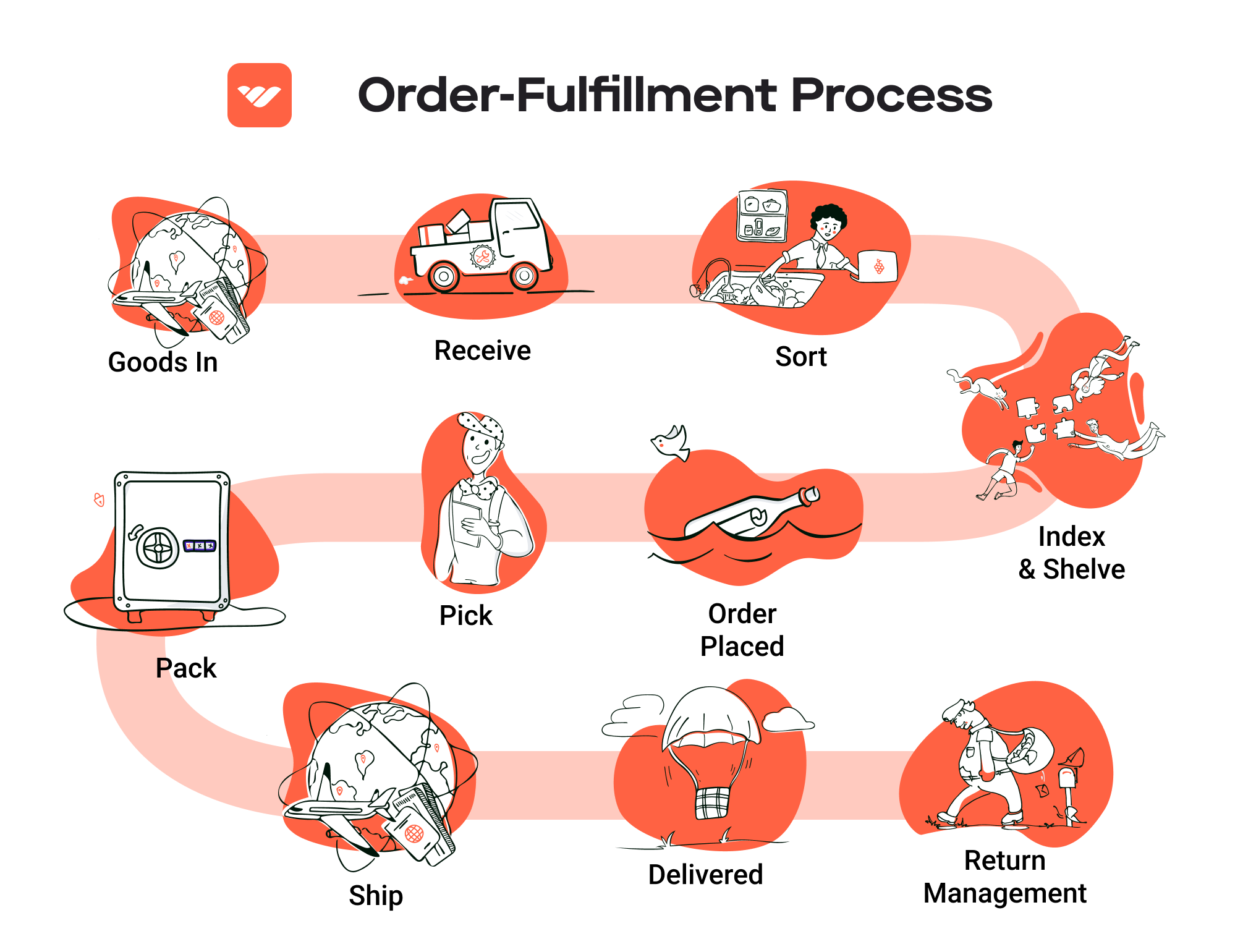
Shipping and delivery are pivotal in the customer experience. The speed and reliability of this step can significantly impact customer satisfaction and loyalty. Businesses can offer various shipping options, such as standard, expedited, or same-day delivery, to cater to different customer needs.
Importance: Efficient shipping processes can lead to faster delivery times, which are increasingly critical in today’s e-commerce landscape. By optimizing shipping strategies and leveraging technology, businesses can enhance their overall fulfillment efficiency and customer satisfaction.
In summary, understanding and optimizing each step of the order fulfillment process—from receiving inventory to shipping and delivery—can greatly enhance operational efficiency, reduce costs, and improve customer satisfaction. By focusing on these critical areas, e-commerce businesses can position themselves for scalable growth in a competitive market.
Comparing Fulfillment Models: In-House vs. 3PL vs. Dropshipping
Fulfillment Model Comparison
| Model | Who Handles Inventory | Best For (Business Stage) | Key Advantage | Key Disadvantage |
|---|---|---|---|---|
| In-House Fulfillment | Your business | Established businesses with stable demand | Complete control over inventory and operations | High overhead costs and complexity |
| Third-Party Logistics (3PL) | Third-party provider | Growing businesses and startups | Scalability and expertise | Less control over fulfillment process |
| Dropshipping | Supplier | New businesses or niche products | Low startup costs and minimal risk | Lower profit margins and reliance on suppliers |
In-House Fulfillment
In-house fulfillment involves managing all aspects of inventory and order processing within your own facilities. This model is best suited for established businesses that have a stable demand and can afford the overhead costs associated with maintaining a warehouse, staff, and logistics operations. The key advantage of in-house fulfillment is that it provides complete control over inventory management, quality assurance, and customer experience. Businesses can customize their packaging, branding, and shipping processes to better align with their overall brand strategy.
However, the disadvantages can be significant. Operating an in-house fulfillment center requires substantial investment in warehousing space, technology, and human resources. This model can lead to higher overhead costs and increased complexity in operations, especially as order volumes fluctuate. Additionally, businesses may face challenges in scaling operations rapidly to meet spikes in demand or seasonal variations. Hence, while in-house fulfillment offers control, it often requires a robust infrastructure and financial commitment.
Third-Party Logistics (3PL)
Third-party logistics (3PL) providers manage various logistics functions on behalf of businesses, including warehousing, inventory management, and shipping. This model is particularly beneficial for growing businesses and startups that are looking to scale quickly without the burden of managing their own fulfillment operations. The primary advantage of using a 3PL is scalability; businesses can expand their operations without significant upfront investments in facilities or technology. Additionally, 3PL providers often have established networks and expertise in logistics, allowing for more efficient order processing and shipping.
However, one of the main drawbacks of utilizing a 3PL is the reduced control over the fulfillment process. Businesses must rely on their provider to maintain quality standards and ensure timely deliveries, which can sometimes lead to discrepancies in service levels. Communication can also be a challenge, especially if the 3PL is located far from the business’s operational base. Furthermore, the costs associated with 3PL services can vary, and businesses may face unexpected fees that could impact their profitability.
Dropshipping
Dropshipping is a fulfillment model where the retailer does not keep products in stock but instead transfers customer orders directly to a supplier, who then ships the products directly to the customer. This model is ideal for new businesses or those venturing into niche markets, as it requires minimal upfront investment and allows entrepreneurs to test product ideas without the risk of holding inventory. The primary advantage of dropshipping is its low startup costs and reduced financial risk. Retailers can offer a wide range of products without the need for warehousing or inventory management.
On the downside, dropshipping often comes with lower profit margins compared to other fulfillment models. Retailers are at the mercy of their suppliers regarding product availability, shipping times, and quality control. This reliance can lead to inconsistent customer experiences, which can damage brand reputation. Additionally, competition can be fierce, as many retailers may be sourcing from the same suppliers, making it challenging to differentiate products and maintain competitive pricing. Thus, while dropshipping offers an accessible entry point into e-commerce, it requires careful supplier management and marketing strategies to succeed.
A Deep Dive into Amazon FBA: Pros, Cons, and Who It’s For
What is Fulfillment by Amazon (FBA)?
Fulfillment by Amazon (FBA) is a service offered by Amazon that allows e-commerce businesses to leverage Amazon’s vast logistics network to store, package, and ship their products directly to customers. This service enables sellers to focus on their core business activities, such as product development and marketing, while Amazon takes care of the logistics and customer service aspects.
When a seller enrolls in FBA, their products are stored in Amazon’s fulfillment centers. Amazon handles the storage, packaging, and shipping of these products. When a customer places an order, Amazon picks, packs, and ships the item on behalf of the seller. Furthermore, FBA products are automatically eligible for Amazon Prime, which can significantly enhance visibility and sales potential.
How FBA Works
-
Product Listing and Enrollment: Sellers create product listings on Amazon and choose which items they want to fulfill through FBA. They then ship their inventory to Amazon’s fulfillment centers.
-
Storage and Management: Once the products arrive at Amazon’s facilities, they are stored until an order is placed. Sellers can track inventory levels through the Amazon Seller Central dashboard.
-
Order Fulfillment: When a customer places an order for an FBA product, Amazon takes over the fulfillment process. They pick the item from the warehouse, package it, and ship it directly to the customer.
-
Customer Service and Returns: Amazon manages customer service inquiries and handles returns for FBA products, allowing sellers to focus on other aspects of their business.
-
Payment and Fees: After an order is fulfilled, sellers receive payment, minus Amazon’s FBA fees, which cover storage, fulfillment, and other associated costs.
Pros of Using Amazon FBA
-
Prime Eligibility: One of the most significant advantages of FBA is that it makes products eligible for Amazon Prime. This feature attracts millions of Prime members who prefer fast, free shipping, thereby increasing sales potential.
-
Customer Trust: Products fulfilled by Amazon benefit from the trust associated with Amazon’s brand. Customers are often more likely to purchase items that are backed by Amazon’s fulfillment and customer service.
-
Multi-Channel Fulfillment: FBA isn’t limited to sales on Amazon. Sellers can use FBA to fulfill orders from their own websites or other e-commerce platforms. This flexibility allows for a streamlined logistics process across various sales channels.
-
Scalability: FBA allows businesses to scale operations without the need for additional warehousing or logistics management. As order volumes increase, sellers can rely on Amazon’s infrastructure to handle the growth.
-
Time-Saving: By outsourcing logistics to Amazon, sellers can save time and resources that would otherwise be spent on packing, shipping, and customer service.
Cons of Using Amazon FBA
-
High Fees: FBA fees can be substantial, including storage fees for holding inventory in Amazon’s fulfillment centers and fulfillment fees for each order shipped. These costs can eat into profit margins, especially for lower-priced items.
-
Strict Inventory Rules: Amazon has stringent inventory management policies. Sellers must adhere to guidelines regarding stock levels, packaging, and labeling. Failure to comply can result in penalties or even suspension from FBA.
-
Commingling Risks: FBA utilizes a commingling inventory system, where products from multiple sellers can be stored in the same location. This practice can lead to issues if a customer receives a defective or counterfeit item, as it may be difficult for sellers to track and address such problems.
-
Loss of Control: When using FBA, sellers relinquish some control over the fulfillment process. This can be a concern for businesses that prioritize custom packaging or specific shipping methods.
-
Long-Term Storage Fees: If inventory remains unsold for an extended period, sellers may incur long-term storage fees. This can create pressure to move inventory quickly, potentially leading to price reductions or clearance sales.
Who is FBA Best For?
Fulfillment by Amazon is particularly advantageous for:
-
Small to Medium-Sized Businesses: Sellers with limited resources can benefit from outsourcing logistics to Amazon, allowing them to focus on growth and marketing.
-
High-Volume Sellers: Businesses that experience consistent sales can take advantage of FBA’s economies of scale, making it cost-effective to use Amazon’s fulfillment services.
-
Brands Seeking Prime Membership: For brands that want to tap into the Prime membership base, FBA is an essential tool for increasing visibility and sales.
-
Multi-Channel Sellers: Businesses that sell across multiple platforms can streamline their logistics by using FBA for all order fulfillment, regardless of the sales channel.
-
Sellers of Consumable Goods: For businesses selling products with a shorter shelf life or seasonal items, FBA can help manage inventory turnover more effectively.
In conclusion, while Fulfillment by Amazon offers numerous benefits that can significantly enhance an e-commerce business’s operations and sales potential, it is crucial for sellers to weigh these advantages against the potential downsides. By carefully considering their specific business needs and goals, sellers can make informed decisions about whether FBA is the right fit for their operations.
Core Services Offered by Fulfillment Centers
Inventory Management & Warehousing
Inventory management and warehousing are foundational services offered by fulfillment centers. This service involves the systematic control of stock levels, ensuring that e-commerce businesses can maintain optimal inventory without overstocking or running out of products. Fulfillment centers utilize advanced inventory management systems that track inventory in real-time, allowing businesses to monitor stock levels, product turnover, and demand patterns effectively.
Benefits:
1. Enhanced Visibility: By leveraging technology, fulfillment centers provide e-commerce businesses with real-time insights into their inventory status, enabling informed decision-making.
2. Cost Efficiency: Proper inventory management reduces holding costs and minimizes the risk of stockouts, helping to improve cash flow and profitability.
3. Space Optimization: Fulfillment centers have dedicated warehousing space designed to maximize storage efficiency, freeing e-commerce businesses from the burden of managing their own storage facilities.
4. Scalability: As businesses grow, fulfillment centers can easily adapt to increased inventory demands without the need for significant capital investment in additional warehousing space.
Pick and Pack Services
Pick and pack services are essential for the efficient processing of customer orders. This service entails the selection (picking) of products from the warehouse and preparing them for shipment (packing). Fulfillment centers employ trained personnel and automated systems to streamline this process, ensuring accuracy and speed.
Benefits:
1. Order Accuracy: Fulfillment centers utilize technology to minimize picking errors, ensuring that customers receive the correct products, which enhances customer satisfaction and loyalty.
2. Efficiency: With trained staff and optimized processes, fulfillment centers can pick and pack orders faster than most businesses can do in-house, leading to quicker delivery times.
3. Cost Savings: By outsourcing pick and pack services, e-commerce businesses can save on labor costs and reduce overhead associated with maintaining an in-house fulfillment team.
4. Flexible Order Handling: Fulfillment centers can manage varying order sizes and complexities, from single-item orders to bulk shipments, accommodating the diverse needs of e-commerce businesses.
Kitting and Assembly
Kitting and assembly services involve the grouping of individual items into ready-to-sell packages or the assembly of products from multiple components. This service is particularly beneficial for e-commerce businesses that sell products that require assembly or bundling, such as subscription boxes or promotional kits.
Benefits:
1. Customization: Kitting allows businesses to create unique product offerings tailored to specific customer segments, enhancing the shopping experience and driving sales.
2. Time Savings: By outsourcing kitting and assembly tasks, e-commerce businesses can focus on core activities such as marketing and customer service, rather than logistical complexities.
3. Quality Control: Fulfillment centers typically have quality control processes in place to ensure that assembled kits meet product specifications and are packaged correctly before shipment.
4. Inventory Management: Kitting can improve inventory turnover rates by allowing businesses to sell bundled products that may not have moved individually, thus reducing excess stock.
Returns Management (Reverse Logistics)
Returns management, also known as reverse logistics, is a critical service offered by fulfillment centers that involves handling product returns efficiently. This service encompasses the processes of receiving returned items, inspecting their condition, restocking, and managing refunds or exchanges.
Benefits:
1. Customer Satisfaction: Efficient returns management can significantly enhance customer satisfaction, as customers appreciate hassle-free return processes. This can lead to increased customer loyalty and repeat purchases.
2. Cost Efficiency: Fulfillment centers can streamline the returns process, reducing the operational costs associated with handling returns in-house.
3. Data Insights: By analyzing return data, e-commerce businesses can identify trends, such as common reasons for returns, and make informed decisions to improve product quality or customer service.
4. Inventory Recovery: Effective returns management allows businesses to quickly reintegrate returned products back into inventory, minimizing loss and maximizing the potential for resale.
In conclusion, partnering with a fulfillment center can provide e-commerce businesses with a range of core services that enhance operational efficiency, improve customer satisfaction, and support scalable growth. By leveraging these services, businesses can focus on their core competencies while leaving logistics and fulfillment in the hands of experts.
How to Choose a Fulfillment Partner: A 6-Point Checklist
Location & Warehouse Network
Choosing a fulfillment partner with a strategically located warehouse network is crucial for optimizing shipping times and costs. The closer your fulfillment partner is to your customer base, the faster and more cost-effective your delivery can be.
Questions to Ask:
– What are the locations of your warehouses, and how do they align with my target markets?
– How do you manage inventory across multiple locations?
– Can you accommodate regional shipping demands and fluctuations?
Technology & Integrations
In today’s digital landscape, the technology a fulfillment partner uses can significantly impact your operations. A robust technology platform should offer real-time inventory tracking, order management, and seamless integration with your e-commerce platforms.
Questions to Ask:
– What technology do you use for order processing and inventory management?
– How do you integrate with existing e-commerce platforms (like Shopify, WooCommerce, or Amazon)?
– Can I access real-time data and analytics on my orders and inventory?
Specializations
Not all fulfillment centers are created equal. Depending on your product type, you may need a partner that specializes in certain areas, such as cold storage for perishable goods, handling oversized items, or managing hazardous materials.
Questions to Ask:
– Do you have experience handling products similar to mine?
– What special services do you offer (e.g., kitting, assembly, cold storage)?
– How do you ensure compliance with industry regulations for specialized products?
Scalability & Capacity
As your business grows, your fulfillment needs will change. A good partner should not only be able to handle your current volume but also scale with your business. This includes having the physical capacity and the operational flexibility to manage seasonal spikes and growth.
Questions to Ask:
– How do you handle seasonal fluctuations in order volume?
– What is your maximum capacity, and how quickly can you scale up operations?
– Do you have a plan in place for unexpected surges in demand?
Pricing and Contracts
Understanding the pricing structure and contract terms of your fulfillment partner is critical to managing your overall logistics costs. Look for transparency in pricing and be wary of hidden fees that can accumulate over time.
Questions to Ask:
– What is your pricing model (e.g., per order, per item, monthly fees)?
– Are there any additional fees for services like storage, returns, or special handling?
– What are the contract terms, and is there flexibility for renegotiation as my business evolves?
Customer Support & Reviews
Reliable customer support can make or break your partnership with a fulfillment center. You want a partner that is responsive and proactive in addressing issues as they arise. Additionally, researching reviews from other clients can provide insight into their reliability and service quality.
Questions to Ask:
– What kind of customer support do you offer (e.g., phone, email, chat)?
– What are your average response times for support inquiries?
– Can you provide references or case studies from similar businesses?
Conclusion
Choosing the right fulfillment partner is a vital step in scaling your e-commerce business. By focusing on these six key areas—Location & Warehouse Network, Technology & Integrations, Specializations, Scalability & Capacity, Pricing and Contracts, and Customer Support & Reviews—you can make an informed decision that aligns with your business goals. Take the time to evaluate potential partners thoroughly, as the right choice can lead to enhanced operational efficiency, improved customer satisfaction, and ultimately, greater business success.
Understanding Fulfillment Pricing: A Breakdown of Common Fees
Initial Setup Fees
When you begin using a fulfillment center like Amazon FBA, an initial setup fee may be applicable. This fee typically covers the administrative costs associated with onboarding your account, integrating your inventory management system, and setting up your product listings. The initial setup fee can vary widely based on the complexity of your operations and the specific services you require. For instance, if you have a large catalog or require custom packaging solutions, expect higher fees. To mitigate these costs, it’s beneficial to streamline your inventory processes and ensure all product data is accurate and ready for upload.
Receiving Fees
Receiving fees are charged when your inventory arrives at the fulfillment center. These fees cover the labor and resources required to unpack, inspect, and store your products. The receiving fee is generally calculated based on the number of items received or the volume (weight or cubic feet) of the shipment. For example, if you send in a pallet of goods, the receiving fee may be charged per pallet. Understanding the specifics of how receiving fees are structured can help you plan shipments more efficiently, potentially reducing costs by consolidating shipments to maximize the volume received at one time.
Storage Fees (per pallet/bin)
Storage fees are incurred for keeping your inventory in the fulfillment center. These fees can be charged monthly and are typically calculated on a per-pallet or per-bin basis, depending on the size and quantity of your inventory. For instance, if you store multiple pallets, you will pay a fee for each pallet stored. Additionally, many fulfillment centers implement tiered pricing based on the amount of space you occupy—meaning that the more space you use, the lower the per-pallet fee may become. It is essential to monitor your inventory levels regularly, as long-term storage fees may apply if products remain unsold for extended periods. This can incentivize you to run promotions or optimize your inventory turnover.
Pick & Pack Fees (per item/order)
Pick and pack fees are charged for the labor involved in selecting items from your inventory and packing them for shipment. These fees are usually calculated on a per-item or per-order basis. For example, if an order consists of three different items, you may incur a pick fee for each item as well as a pack fee for the entire order. This fee structure encourages businesses to optimize their order sizes; larger orders with fewer line items can reduce overall pick and pack costs. Additionally, consider the packaging materials used, as premium packaging may incur additional costs. Analyzing your order patterns can help streamline this process and reduce associated fees.
Shipping Fees
Shipping fees cover the cost of transporting your products from the fulfillment center to the customer. These fees are often influenced by several factors, including the shipping destination, the weight and dimensions of the package, and the shipping method chosen (standard, expedited, etc.). Fulfillment centers typically provide various shipping options, and it’s crucial to assess which methods balance cost and delivery speed effectively. Some providers may offer discounts for bulk shipping or partnerships with carriers, which can significantly lower costs. Understanding your customer base’s preferences for shipping can help you choose the right options to enhance customer satisfaction while managing expenses.
Tips for Getting an Accurate Quote
To ensure you receive an accurate quote for fulfillment services, consider the following strategies:
-
Detailed Inventory List: Provide a comprehensive list of your products, including dimensions, weights, and quantities. This helps the fulfillment center assess storage and shipping needs accurately.
-
Clarify Services Needed: Be clear about the specific services you require, such as kitting, custom packaging, or international shipping. Each additional service can influence your costs.
-
Understand Fee Structures: Ask for a breakdown of how each fee is calculated. Understanding the nuances of their pricing models will help you identify potential areas for cost savings.
-
Negotiate Rates: If you plan to send a high volume of products, inquire about bulk discounts or custom pricing structures based on your projected shipping and storage needs.
-
Request Scenarios: Ask for quotes based on different order scenarios (e.g., peak seasons, holiday sales) to understand how fluctuations in demand can affect your overall costs.
By taking these steps, you can gain a clearer picture of your fulfillment costs and make informed decisions that support your business’s growth.
Frequently Asked Questions (FAQs) about Fulfillment
1. What is the Amazon Fulfillment Center PHX6?
The Amazon Fulfillment Center PHX6 is a logistics facility located at 4750 W. Mohave Street, Phoenix, AZ 85043. It is part of Amazon’s extensive network of fulfillment centers designed to store, pick, pack, and ship products for sellers using Amazon’s Fulfillment by Amazon (FBA) service. This center plays a critical role in ensuring quick and efficient delivery to customers in the surrounding areas.
2. How does the fulfillment process work at PHX6?
At PHX6, the fulfillment process typically involves several key steps:
1. Receiving Inventory: Products are received from sellers and organized in the warehouse.
2. Storage: Items are stored in designated areas for easy retrieval.
3. Order Processing: When a customer places an order, the system identifies the location of the product.
4. Picking: Staff or robots pick the items from the shelves.
5. Packing: The items are packed securely for shipment.
6. Shipping: Orders are dispatched for delivery to the customer’s address.
3. What is the difference between a warehouse and a fulfillment center?
A warehouse primarily focuses on storing products, whereas a fulfillment center is designed for processing orders. Fulfillment centers not only store inventory but also handle the logistics of order processing, including picking, packing, and shipping products directly to customers. Essentially, all fulfillment centers are warehouses, but not all warehouses are fulfillment centers.
4. How much do fulfillment services cost?
The cost of fulfillment services can vary based on several factors, including:
– Storage Fees: Charged monthly based on the amount of space your products occupy.
– Fulfillment Fees: Charged per order, which can include picking, packing, and shipping costs.
– Additional Services: Fees for extra services such as labeling, returns processing, or special packaging.
On average, fulfillment costs can range from $2 to $5 per order, plus storage fees that can be around $0.75 to $2.50 per cubic foot per month, depending on the provider and location.
5. What are the benefits of using Amazon FBA at PHX6?
Using Amazon FBA at PHX6 offers several advantages:
– Fast Shipping: Leverage Amazon’s Prime shipping options to provide customers with quick delivery.
– Scalability: Easily scale your business without needing to manage logistics yourself.
– Customer Service: Amazon handles customer inquiries and returns, allowing you to focus on sales and marketing.
– Access to a Large Customer Base: Products fulfilled through Amazon are eligible for Amazon’s vast marketplace, increasing visibility.
6. What types of products can be stored at PHX6?
PHX6 can store a wide variety of products, including consumer electronics, clothing, household goods, and more. However, certain restrictions apply, such as hazardous materials, perishables, and prohibited items as per Amazon’s guidelines. It is essential to review Amazon’s policies before sending products to ensure compliance.
7. How can I manage my inventory at PHX6?
Inventory management at PHX6 can be efficiently handled through Amazon’s Seller Central platform. You can track inventory levels, set alerts for low stock, and manage listings. Additionally, using inventory management software can help streamline processes and provide real-time data on stock levels, sales velocity, and more.
8. What is a 3PL and how does it relate to Amazon FBA?
A 3PL, or Third-Party Logistics provider, is a company that offers logistics services, including warehousing, fulfillment, and transportation. While Amazon FBA itself is a type of 3PL service, many sellers may choose to use other 3PL providers for various reasons, such as specific shipping needs, cost considerations, or to handle products that do not meet Amazon’s FBA criteria.
9. How can I optimize my fulfillment strategy with PHX6?
To optimize your fulfillment strategy with PHX6, consider the following:
– Utilize Amazon’s Inventory Management Tools: Leverage tools in Seller Central to track and manage your inventory effectively.
– Analyze Sales Data: Use sales metrics to forecast demand and adjust inventory levels accordingly.
– Optimize Listings: Ensure product listings are optimized for search visibility to drive more sales.
– Monitor Performance Metrics: Regularly review fulfillment performance metrics to identify areas for improvement.
10. What are the shipping options available for orders fulfilled at PHX6?
Orders fulfilled at PHX6 benefit from a variety of shipping options, including:
– Standard Shipping: Typically takes 3-5 business days for delivery.
– Expedited Shipping: Faster delivery options are available for an additional fee.
– Amazon Prime: Eligible items can be delivered within two days for Prime members.
– Same-Day or One-Day Delivery: Available for select products and locations, enhancing customer satisfaction.
By understanding and leveraging the capabilities of the Amazon Fulfillment Center PHX6, e-commerce businesses can enhance their logistics operations, improve customer satisfaction, and scale effectively.
Conclusion: Is Outsourcing Fulfillment the Right Move for Your Business?
Evaluating the Benefits of Outsourcing Fulfillment
Outsourcing fulfillment can be a transformative decision for e-commerce businesses looking to scale. By leveraging a fulfillment service, you can save valuable time and resources that would otherwise be spent managing logistics. This allows you to focus on core business activities such as marketing, product development, and customer engagement.
Another significant advantage is scalability. As your business grows, your fulfillment needs will inevitably change. A fulfillment partner can provide the infrastructure necessary to handle increased order volumes without the need for significant capital investment in warehousing or technology. This flexibility ensures that you can adapt quickly to market demands and seasonal fluctuations, keeping your operations agile.
Moreover, fulfillment centers bring expertise that can enhance your overall efficiency. They are equipped with advanced technology and experienced personnel who understand the nuances of inventory management, order processing, and shipping. This expertise can lead to improved accuracy, faster delivery times, and ultimately, higher customer satisfaction.
However, the success of outsourcing fulfillment hinges on choosing the right partner. It’s essential to evaluate potential partners based on their service offerings, technology capabilities, and alignment with your business goals. A well-chosen partner will not only support your current needs but also be a strategic ally as you grow.
Take Action
To determine if outsourcing fulfillment is the right next step for your business, consider conducting a thorough audit of your current shipping processes. Identify pain points, bottlenecks, and areas where efficiency can be improved. This exercise will provide clarity on whether a fulfillment partner can help you achieve your growth objectives and enhance your operational capabilities. Taking this proactive approach can set your business on a path to greater success and sustainability in the competitive e-commerce landscape.
Important Disclaimer
⚠️ Important Disclaimer
The information in this guide is for educational purposes. Fulfillment services, pricing, and platform features change frequently. Always conduct your own due diligence and consult with providers directly before making business decisions.
